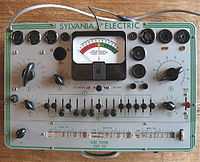Tube tester

A tube tester is an electronic instrument designed to test certain characteristics of vacuum tubes (thermionic valves). Tube testers evolved along with the vacuum tube to satisfy the demands of the time, and this evolution faded with the tube era, yet with the High-End advent, they became a pricey piece of equipment. The first tube testers were simple units designed for specific tubes to be used in the battlefields of World War I by radio operators, so they could easily test the tubes of their communication equipment.
Types of tube testers
Modern testers
These perform a multitude of the below tests and are fully automated. Examples of modern testers include the Amplitrex AT1000, the Maxi pre-amp tester and the maxi-matcher(power tubes only)by maxi test and the new and somewhat more primitive DIVO VT1000 by Orange Amplification. While the AT1000 and the Maxi-test brand testers offer precise measurements of transconductance/Gm and emissions/iP at full or near full voltages the Orange tester offers a very simple numerical quality scale.
Filament continuity tester
The simplest one is the filament continuity tester, usually with a neon lamp connected in series with the filament and a current limiting resistance fed directly by the mains.
Tube checker
The simplest of all tube testers. Tubes are used as low power rectifier, at a fraction of its normal emission. By mistake referred to as Emission Tester sometimes.
Emission tester
Next in complexities is the emission tester, which basically treats any tube as a diode by carefully connecting the cathode to ground, all the grids and plate to B+ voltage, feeding the filament with the correct voltage, and an ammeter in series with either the plate or the cathode. This effectively measures emission, the current which the cathode is capable of emitting, for the given plate voltage, which can usually be controlled by a variable load resistor.
Older testers may call themselves Plate Conductance if the ammeter is in series with the plate, or Cathode Conductance if the meter is in series with the cathode.[1]
The problems of emission testers are:
- they do not measure key characteristics of tubes, like transconductance
- they do not perform the tests at real load, voltages and currents
- they test the tube under static conditions, which are not even near the dynamic conditions the tube would work with in a real electronic device
- tubes with grids, might not even show the real emission because of hot spots in the cathode, hidden by the grids under normal conditions
The advantage of an Emission Tester is, from all types of tube testers available, it gives the most reliable warning for tube wear out. If Emission is at 70%, transconductance can be at 90% still, and gain at 100%. Best and most popular Version used by the German army, is the Funke W19.
The disadvantage of an Emission Tester is, it can test a good tube as bad, and a bad tube as good, because other qualities of the tube are ignored by this type of Tube Tester. In America, Drug Store Tube Testers were very popular, and were intended to make money for their proprietors. Many Tubes were sold that were not needed based on the criteria of Low Emission. A Tube with Low Emission will work perfectly fine in most circuits, and should not be replaced by that indication alone, unless it measures much lower than specified or if it indicates a short.
Short circuit test
Usually, emission testers and better testers have a short circuit test which is just a variation of the continuity tester with a neon lamp, and which allows to identify if there is any shortcut between the different electrodes.
Parametrical tester, DC Type
This tester Applies DC voltage to the Tube under Test, and datasheet values are verified under real conditions. Good examples are Funke W20 and Neuberger RPG375.
Parametrical tester, AC Type
This tester Applies AC voltage to the Tube under Test, and datasheet values are verified under conditions which simulate DC operation. Most popular are the AVO testers.
Mutual conductance tester
The mutual conductance tester tests the tube dynamically by applying bias and an AC voltage to the control grid, and measuring the current obtained on the plate, while maintaining the correct DC voltages on the plate and screen grid. This setup measures the transconductance of the tube, indicated in micromhos.[2]
Dynamic conductance tester
The dynamic conductance tester is just a variation of the emission tester with its implications, where a proportional AC voltage is applied to each electrode. This tester exists thanks to Jackson mainly to avoid infringing the patents of the mutual conductance tester held by Hickok Electrical Instrument Company, but obviously do not provide the same measurements.
Oscilloscope tube curve tracer plug-in
A full set of characteristic curves for vacuum tubes, and later for semiconductor devices, could be displayed on an oscilloscope screen by use of a plug-in adaptor, or on a dedicated curve tracer. An example is the Tektronix 570;[3] this instrument as of 2011 is rare but still sought after, and sells for thousands of US dollars.
References
- ↑ Know your Tube and Transistor Testers, Robert G. Middleton
- ↑ "Mutual Conductance vs. Emission Test". RadiolaGuy.com. Retrieved 2010-12-08.
- ↑ Radiomuseum: Electron Tube Curve Tracer 570